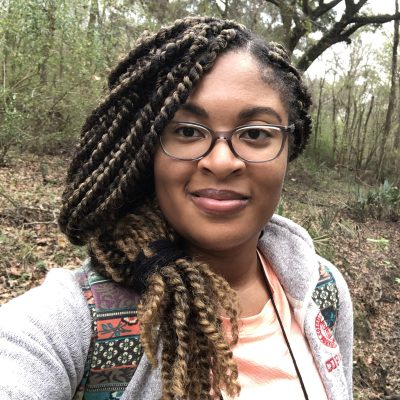Student Spotlight: Ayress Grinage

September 19, 2022
Ayress Grinage is a doctoral candidate in plant biology who, as a military child, has lived in multiple places across the U.S. and abroad. She attended the University of Florida as an undergraduate and now studies plant evolution and biodiversity with a focus on the palm tree species Sabal minor.
What is your area of research and why is it important?
My research area is broadly on plant evolution and biodiversity, where I leverage natural history collections as well as field data to identify and define plant diversity in the Neotropics. In the true spirit of the Neotropics, I study palm trees; specifically a species that is restricted to the wetland forests of the Southeastern United States known as the dwarf palmetto (Sabal minor). This palm, as the name “dwarf” implies, is unlike what many people imagine when they think of a palm tree because it is trunkless. This trunklessness is actually ecologically intriguing because trunklessness in other palms has been associated with historical shifts in climate. Furthermore, along the Gulf Coast within the bayous of Louisiana, Mississippi, and Alabama, the dwarf palmetto contains enigmatic populations that develop a tall trunk. These unusual populations of the dwarf palmetto along the Gulf Coast were so mysterious that they drew the attention of L.H. Bailey (the founder of the Cornell herbarium, known as the L.H. Bailey Hortorium) and his contemporaries. Because this one species developmentally maintains populations with trunkless and trunked forms, understanding this morphological diversity offers substantial insight into the historical and future climate of the Southeastern United States’ subtropical/tropical wetland forests and the subsequent resiliency of plants and animals within this ecosystem.
What are the larger implications of this research?
Palms are charismatic plants that dominate the natural landscapes of tropical and subtropical ecosystems. Because palms are limited in distribution by the confines of warm, tropical climates, they are a powerful indicator of the stability and health of some of the world’s most biodiverse habitats. By mapping the demographics, population dynamics, and ecological interactions of palm species in specific niches where they act as keystone species, we can take proactive measures for the conservation of entire ecosystems before the interactive webs involving plants, animals, fungi, and microbes become critically endangered.
What does it mean to you to have received an HHMI Gilliam Fellowship?
It is a huge honor to receive the HHMI Gilliam Fellowship because this award signified recognition of the importance of my field and of my potential to thrive as a scientist. I am furthermore very excited to have received this award under the mentorship of my advisor, Dr. Chelsea Specht, with whom I’ve discussed many ideas within the scope of my field to expand the boundaries of biodiversity and botanical research. Now, with this fellowship, I have many more resources, including much needed time to act on some of these ideas.
What will this fellowship allow you and your mentor to do?
Because this fellowship is awarded to both student and advisor, I along with my advisor will be able to benefit from interacting within the HHMI community. For my advisor specifically, that looks like engaging in a culturally responsive mentorship development program and community support (i.e., workshops) to address institutional challenges to diversity and inclusion at the graduate level, as well as the ability to engage within the community of advisors to share knowledge and experiences. For me, this fellowship will allow me to share my research and promote natural history research within a broader niche of scientists as a part of the HHMI Gilliam community. Within this community, I will likewise be able to engage other HHMI scholars and scientists from across the nation and be able to pursue collaborations to expand the scope of my research and development as a scientist.
What are your hobbies or interests outside of your research or scholarship?
Outside of my research, I enjoy reading fiction novels, spending time outdoors, and honing my informal mixology skillset.
Why did you choose Cornell to pursue your degree?
I chose Cornell because I really enjoy the mentorship style of my advisor and our creative energy when we are working together on ideas and projects. It is so incredible that I am always walking away with more ideas to pull into my research and academic experience. I have a very interdisciplinary background, so being able to pull on many of my different experiences for my dissertation is invaluable for me. Additionally, because I study palm trees, Cornell is actually one of the best places to study palm diversity because it is home to the second biggest palm collection in the world in the L.H. Bailey Hortorium, behind the Royal Botanical Garden at Kew. My research is heavily reliant on field work and natural history collections, so the expansive palm collection in the L.H. Bailey Hortorium was a huge draw for me.
